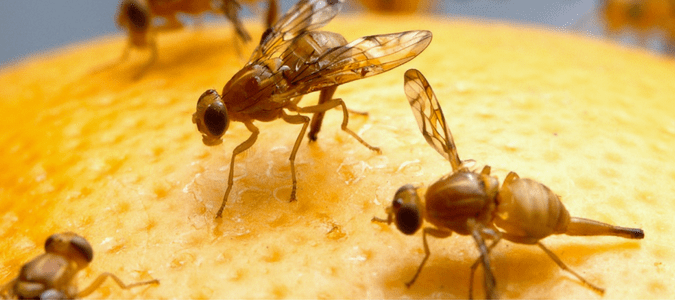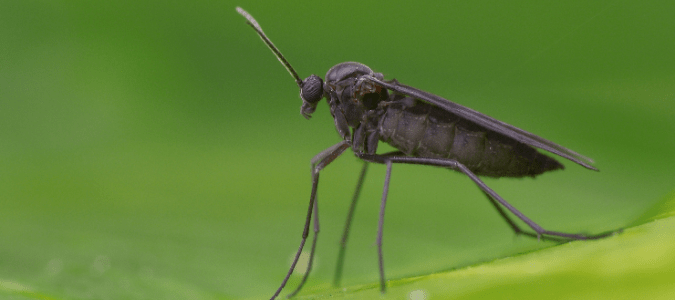When you spot tiny insects buzzing around your home, you probably assume they’re fruit flies and you’re probably right. What about when you see what looks like the same insects outside, or in another room in the house? Fungus gnats look a lot like fruit flies and behave in similar ways. Even though these insects are both annoying, there are distinct differences between them. Knowing which one you’re dealing with will help you determine how to deal with them.
Fruit flies and fungus gnats can appear to look the same, but this is only because they’re so tiny. Each insect is only about an eighth of an inch long, making it hard to see their individual characteristics with the naked eye. However, if you could see each one up close, you would see they look pretty different from each other.
Identifying Fruit Flies
Fruit flies are like tiny versions of house flies. They have rounded bodies that are a tan or brownish color and big, bulbous, red eyes. Of course, when they’re flying around the bowl of fruit you keep on your counter, you won’t be able to see them closely. All you will see is what looks like a swarm of annoying gnats.
Fruit flies live indoors and outdoors but always near the overripe or rotting foods they feed on. The smells these foods put out attract them. This is why these insects are most often seen during warmer months when fruits and vegetables are quickest to ripen. They can be a problem year-round, however.
Inside the house, fruit flies are most often found in the kitchen, where people keep produce like fruit and onions out on the counter. Outside, these pests are often found flying around garbage or compost bins.
Fruit flies don’t just feed on ripe or rotting produce. Instead, they actually lay their eggs on the surface of fruits and vegetables. Indoors, they’re also known to lay eggs in the slimy gunk that accumulates around the kitchen sink drain. Outside, they might lay eggs in the same type of sludge found in the bottom of a garbage or compost bin. These spots offer nutrition to tiny fruit fly larvae as they hatch from their eggs.
Fruit flies reproduce quickly—just one female can lay hundreds of eggs. And these insects move quickly through their life cycle, developing from egg to adult in a matter of a week. This is why fruit flies can get so out of hand so quickly.
They might come into your home in the form of eggs laid on produce from your garden or the grocery store. They might also fly inside through openings in window or door screens. Once they get in, they breed and develop so fast that, within days, you’ll be batting at full-grown fruit flies that seem to have come out of nowhere.
How to Get Rid of Fruit Flies
Getting rid of fruit flies can be tough. A big part of this battle is limiting their access to food as well as places to breed. This means getting rid of fruit that has gotten too ripe or keeping as much produce as possible in the refrigerator. Fortunately, this will also help keep other pests like cockroaches out of your kitchen.
It’s also wise to keep both indoor and outdoor garbage and compost bins tightly closed, so pests can’t access them. Fix any tears in window screens or gaps around exterior doors, so fruit flies and other pests can’t get inside. If you have fruit-bearing trees or a vegetable garden in your yard, clear away fallen or rotting produce.
Inside, if your sink or disposal seems to be a breeding spot for fruit flies, there are a few ways to keep it clean. You can dump boiling water down the drain to kill off fruit fly eggs and larvae. You can also clean the drain with baking soda and vinegar.
Washing your fruits and vegetables is helpful in the battle against fruit flies. Most people don’t think about washing produce that you peel, like bananas, oranges or onions. Unfortunately, fruit flies can contaminate the food we intend to eat. The good news is, peeling produce gets rid of any fruit fly eggs and larvae. That means you won’t be eating contaminated food if you peel the outside and eat only the inside.
The main key to getting rid of fruit flies is to get rid of the spots where they breed. For many people, this is too overwhelming of a task. It’s often much faster and easier to hire a pest control professional to get rid of a fruit fly infestation. This will give you peace of mind much sooner. Then, you can keep fruit flies away moving forward with preventative measures.
Identifying Fungus Gnats
If you could see a fungus gnat up close, you’d see it actually looks far less like a fruit fly and much more like a tiny mosquito. As a matter of fact, some people have trouble differentiating between gnats and mosquitoes. These insects’ bodies are narrower and pointier than fruit fly bodies and a darker gray or black color. They also have much smaller heads than fruit flies. Their legs are much longer, and they dangle down in a way that looks like mosquito legs.
Like fruit flies, fungus gnats can be found either outside or inside. When they’re inside, they aren’t always in the kitchen. They nest in soil and feed on organic matter like mulch or leaf mold. This is why they can thrive outside in the yard or indoors in a potted plant. They have access to plenty of organic matter they can feed on in either place.
Female fungus gnats lay their eggs in soil. When the eggs hatch, the larvae can damage the roots of plants as they feed on them. If there are a lot of larvae in one area, you might see the thin trails of slime they leave behind as they move across the leaves of a plant. These look a lot like tiny snail or slug trails.
How to Get Rid of Fungus Gnats
It’s usually not recommended to use insecticides to get rid of these pests inside the house. Controlling gnat populations indoors is all about limiting the moist soil conditions they need to breed.
One helpful step both indoors and outside is to avoid overwatering your plants. Another is not bringing plants home from the nursery that have visible mold on the leaves or in the soil. These plants might already have fungus gnat eggs or larvae developing in the soil.
If you have problems with fungus gnats outside, it’s helpful to fix any drainage issues you have in your yard. This will help the soil in your garden beds dry out between waterings, which will limit fungus gnats’ feeding and breeding. It’s also important to clear away dead leaves and fallen fruits from fruit trees. Otherwise, these may attract gnats and other insect pests.
If fungus gnats are causing problems in or around your home, contact a professional for help. A pest control specialist will make a pest treatment plan to help control fungus gnats on your property.
ABC Can Help With Your Fly Problem
If you’re sick of dealing with fruit flies, fungus gnats or any other flying insects in your home, contact the experts at ABC Home & Commercial Services. We can send out pest control experts to inspect your home for places flies may be entering and identify areas where they’re breeding. With a helping hand from our staff, we can help control these pests!


